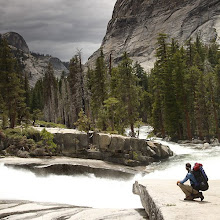I love building projects, tinkering with wood and metal, glues and last minute runs to the hardware store. My latest project is something I've been wanting to do for awhile, to build a camera. If I was going to build a camera I wanted to go all the back, to the very foundations of photography. To have the whole process be 100% homemade. A few years back I received a book on primitive photography as a Christmas present. In it are designs for a sliding a box camera, simple lenses, paper negatives and salt prints (called Calotypes, more on that later). This would be a perfect place to start.
The system the book laid out is the oldest camera system in the world, the very foundation of photography is based on it. It's rather simple. The camera is called a sliding box camera, essentially two nested boxes with the lens at one end and the film plane at the opposite end. Focus is achieved by sliding the rear box in and out until an image is formed on a piece of ground glass. What was revolutionary was the paper negatives that were used. Wax a piece of paper to make it translucent, soak it in a iodized bath solution and coat one side with a mixture of silver nitrate and glacial acid. Contrary to popular belief this first photographic process gave you a dry negative, wet glass plates would come later. This sensitized paper negative was then sandwiched on top of a piece of sensitized paper coated with a solution if silver nitrate and sodium chloride, and exposed to UV light to form a printed image that could be fixed and toned. The negative could be used over and over again, creating the first negative/positive process, later to be replaced by the more popular one-off daguerreotype.
I found a piece of plumbing hardware that works perfectly as a lens housing.
Numbers, numbers, numbers...
After reading the book I noticed several inefficiencies in the author's design and decided to use the book as a guide on general principles but I would design the camera myself. The lens for my camera would be a single element lens called a landscape lens. To get the lens element I disassembled an old Nikon telephoto and extracted several elements, looking for what's called a positive meniscus (concave on one side, convex on the reverse). After getting the element it took a fair bit of math to figure out the lens focal length, angle of view, format and eventual size of the camera. Being my first home built camera I want to keep things size manageable and opted for a 6x6 inch format. The lens element I extracted turned out to have a focal length of 354mm and a diameter of 48mm. A few calculations later I found that it would work great for a format of 6x6 inches (remember, the 'normal' angle lens for any format is equal to its diagonal, my format has a diagonal of 217mm so my lens would be slightly longer angle). Having roughed in several drawings I got a good idea of what materials I needed and stalked up on luan 1/8 inch plywood and several styles of basswood.
Now it's time to start putting the pieces together! Stay tuned!
9.29.2010
9.03.2010
To Seek
The winds of time blow, slowly evaporating into the background of history. What is it we all strive to seek, to find, to discover. I stand at the precipice of a deep canyon and yearn to see the other side, a building thunderstorm obscures my view and I am left with emptiness of thought. Why is it we continue to search the valleys of our soul for answers that may not be there. I turn to the trees, the clouds, the rocks for understanding of the thing I cannot find from within. My eyes continue to guide me deep into the recesses of creativity ever present before me, slightly out of reach, mocking me to answer it's call. For what am I to do but give you the child of my work, born of interpretation of scene, balanced by tone and light. Into the complex duality of life I find myself creeping deeper, hunting for the meaning of it all through the simple act of photographing trees while sitting on a fragrant patch of moss. Perhaps there are no answers, only understanding.
Subscribe to:
Posts (Atom)




